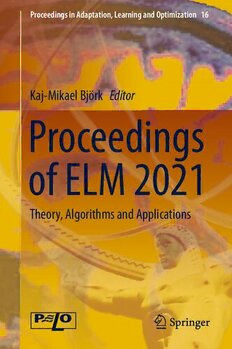Table Of ContentProceedings in Adaptation, Learning and Optimization 16
Kaj-Mikael Björk Editor
Proceedings
of ELM 2021
Theory, Algorithms and Applications
Proceedings in Adaptation, Learning
and Optimization
Volume 16
SeriesEditor
Meng-HiotLim,NanyangTechnologicalUniversity,Singapore,Singapore
Theroleofadaptation,learningandoptimizationarebecomingincreasinglyessential
andintertwined.Thecapabilityofasystemtoadapteitherthroughmodificationofits
physiologicalstructureorviasomerevalidationprocessofinternalmechanismsthat
directlydictatetheresponseorbehavioriscrucialinmanyrealworldapplications.
Optimizationliesattheheartofmostmachinelearningapproacheswhilelearning
andoptimizationaretwoprimarymeanstoeffectadaptationinvariousforms.They
usuallyinvolvecomputationalprocessesincorporatedwithinthesystemthattrigger
parametricupdatingandknowledgeormodelenhancement,givingrisetoprogressive
improvement. This book series serves as a channel to consolidate work related to
topics linked to adaptation, learning and optimization in systems and structures.
Topicscoveredunderthisseriesinclude:
(cid:129)
complex adaptive systems including evolutionary computation, memetic
computing, swarm intelligence, neural networks, fuzzy systems, tabu search,
simulatedannealing,etc.
(cid:129)
machinelearning,datamining&mathematicalprogramming
(cid:129)
hybridizationoftechniquesthatspanacrossartificialintelligenceandcomputa-
tionalintelligenceforsynergisticallianceofstrategiesforproblem-solving.
(cid:129)
aspectsofadaptationinrobotics
(cid:129)
agent-basedcomputing
(cid:129)
autonomic/pervasivecomputing
(cid:129)
dynamicoptimization/learninginnoisyanduncertainenvironment
(cid:129)
systemicallianceofstochasticandconventionalsearchtechniques
(cid:129)
allaspectsofadaptationsinman-machinesystems.
Thisbookseriesbridgesthedichotomyofmodernandconventionalmathematical
andheuristic/meta-heuristicsapproachestobringabouteffectiveadaptation,learning
andoptimization.Itpropelsthemaximthattheoldandthenewcancometogether
andbecombinedsynergisticallytoscalenewheightsinproblem-solving.Toreach
suchalevel,numerousresearchissueswillemergeandresearcherswillfindthebook
seriesaconvenientmediumtotracktheprogressesmade.
IndexedbyINSPEC,zbMATH.
AllbookspublishedintheseriesaresubmittedforconsiderationinWebofScience.
Kaj-Mikael Björk
Editor
Proceedings of ELM 2021
Theory, Algorithms and Applications
Editor
Kaj-MikaelBjörk
GraduateSchoolandResearch
ArcadaUniversityofAppliedSciences
Helsinki,Finland
ISSN 2363-6084 ISSN 2363-6092 (electronic)
ProceedingsinAdaptation,LearningandOptimization
ISBN 978-3-031-21677-0 ISBN 978-3-031-21678-7 (eBook)
https://doi.org/10.1007/978-3-031-21678-7
©TheEditor(s)(ifapplicable)andTheAuthor(s),underexclusivelicensetoSpringerNature
SwitzerlandAG2023
Thisworkissubjecttocopyright.AllrightsaresolelyandexclusivelylicensedbythePublisher,whether
thewholeorpartofthematerialisconcerned,specificallytherightsoftranslation,reprinting,reuse
ofillustrations,recitation,broadcasting,reproductiononmicrofilmsorinanyotherphysicalway,and
transmissionorinformationstorageandretrieval,electronicadaptation,computersoftware,orbysimilar
ordissimilarmethodologynowknownorhereafterdeveloped.
Theuseofgeneraldescriptivenames,registerednames,trademarks,servicemarks,etc.inthispublication
doesnotimply,evenintheabsenceofaspecificstatement,thatsuchnamesareexemptfromtherelevant
protectivelawsandregulationsandthereforefreeforgeneraluse.
Thepublisher,theauthors,andtheeditorsaresafetoassumethattheadviceandinformationinthisbook
arebelievedtobetrueandaccurateatthedateofpublication.Neitherthepublishernortheauthorsor
theeditorsgiveawarranty,expressedorimplied,withrespecttothematerialcontainedhereinorforany
errorsoromissionsthatmayhavebeenmade.Thepublisherremainsneutralwithregardtojurisdictional
claimsinpublishedmapsandinstitutionalaffiliations.
ThisSpringerimprintispublishedbytheregisteredcompanySpringerNatureSwitzerlandAG
Theregisteredcompanyaddressis:Gewerbestrasse11,6330Cham,Switzerland
Organizers
Kaj-MikaelBjörk GraduateSchoolandResearch,Arcada
UniversityofAppliedSciences,Helsinki,
Finland
ProfessorJiuwenCao InstituteofInformationandControl,
HangzhouDianziUniversity,Xiasha
Hangzhou,Zhejiang,310018,China
AssociateProfessorChi-ManVong DepartmentofComputerandInformation
Science,UniversityofMacau,Macau,
999078,China
Dr.YoanMiche BellLabs,Nokia,Espoo,Finland;
DepartmentofInformationand
ComputerScience,SchoolofScience,
AaltoUniversity,FI-00076,Finland
v
Contents
PretrainedE-commerceKnowledgeGraphModelforProduct
Classification ...................................................... 1
Chi-ManWong,Chi-ManVong,andYiminZhou
ANovelMethodologyforObjectDetectioninHighlyCluttered
Images ........................................................... 10
KallinCarolusKhan, EdwardRatner, ChristopherDouglas,
andAmauryLendasse
Extreme Learning Machines for Offline Forged Signature
Identification ...................................................... 24
ZhenLi, LeonardoEspinosa-Leal, AmauryLendasse,
andKaj-MikaelBjörk
RandomizedModelStructureSelectionApproachforExtreme
LearningMachineAppliedtoAcidSulfateSoilDetection ............. 32
AntonAkusok,Kaj-MikaelBjörk,VirginiaEstévez,andAntonBoman
Online label distribution learning based on kernel extreme
learningmachine .................................................. 41
JintaoHuangandChi-ManVong
ANewEnergyVehicleThermalRunawayDataProcessingModel
BasedonMachineLearningAlgorithm .............................. 52
LiangXiaoming,FuZhen,LiuXiangchao,PengKai,ChangWei,
andLiYuan
Marital Stability and Divorce Prediction Among Couples:
AMachineLearningApproach ..................................... 68
SadeqFallahtafti, AlirezaFallahtafti, GaryR.Weckman,
andHamideMohammadinasab
vii
viii Contents
PredictingtheLoadingParametersofaSquarePanelUponLinear
Deflection ......................................................... 84
LeonardoEspinosa-Leal,SilasGebrehiwot,andHeikkiRemes
OntheIntensiveCare UnitAdmissionDuring theCOVID-19
PandemicintheRegionofLleida,Spain:AMachineLearning
Study ............................................................. 92
DidacFlorensa, JordiMateo, FrancescSolsona, PereGodoy,
andLeonardoEspinosa-Leal
VerificationofStaticSignaturesusingDynamicTimeWarping
onFeaturesfromHighPressurePoints .............................. 104
RubenAcosta-Velasquez, LeonardoEspinosa-Leal,
AlexanderGarcia-Perez,andKaj-MikaelBjörk
ExtremeLearningMachine-BasedOperationalStateRecognition:
AFeasibilityStudywithMechanicalVibrationData .................. 114
JukkaJunttila,VilleS.Lämsä,andLeonardoEspinosa-Leal
UnsupervisedHandwrittenSignatureVerificationwithExtreme
LearningMachines ................................................ 124
AntonAkusok, LeonardoEspinosa-Leal, AmauryLendasse,
andKaj-MikaelBjörk
ELMShip:AnEfficientShipClassifierUsingExtremeLearning
Machines ......................................................... 135
LeonardoEspinosa-LealandAminMajd
AnExtremeLearningMachineModelforVenuePresenceDetection ... 144
WiqarKhan,AsifRaza,HeidiKuusniemi,MohammedElmusrati,
andLeonardoEspinosa-Leal
Edammo’s Extreme AutoML Technology – Benchmarks
andAnalysis ...................................................... 152
BrandonWarner,EdwardRatner,andAmauryLendasse
MeasuringResearchProductivityatScale ........................... 164
PeggyLindner
AuthorIndex ...................................................... 171
Pretrained E-commerce Knowledge
Graph Model for Product Classification
B
Chi-Man Wong1,2( ), Chi-Man Vong2, and Yimin Zhou3
1 Alibaba Group, Hangzhou, China
[email protected]
2 University of Macao, Macao, China
3 Chinese Academy of Sciences, Beijing, China
Abstract. ProductclassificationinE-commerce platformsaim toclas-
sify a product into correct category, in order to obtain a better guiding
service for customer to purchase. Language model is usually used to
encode product title into product embedding, and then fed into a clas-
sifier for multi-class classification. However, the product title is usually
ambiguousandnoisy,leadingtopoorpredictionperformance.Toaddress
this issue, we propose a novel pretrained E-commerce knowledge graph
(PEKG) model to learn the representation of product from EKG, and
then used it for fine-tuning. We formulate the pretraining on EKG as a
multi-view learning problem, where the EKG is divided into four views.
From PEKG, user and product representation is proposed to learn via
aggregationofitsneighborinformation,andthesemanticmeaningfrom
the EKG is learned via translation-based method. We experimentally
prove that our proposal significantly outperforms baseline,showing that
the PEKG can learn useful representation of product.
· ·
Keywords: Pretrained model Product classification E-commerce
knowledge graph
1 Introduction
E-commerce businesses [12] enable sellers using the Internet and the Web for
business transactions of goods, which is affecting much of people’s daily life due
to its convenience. People can browse and purchase goods from billions of prod-
uct of all kinds easily, leading to the rapid growing transaction on e-commerce
platformsinrecentyears.Duetothemassivescaleandabundantvarietyofprod-
ucts, the organization [2] of the billion items is especially important for guiding
customer to purchase, and hence all items should be well categorised. However,
the categorization of products is very difficult for seller due to the complexity
of the category tree. In real world e-commerce platform, such category tree is
usually contained multiple levels which categorise a product from coarse-to-fine
level, and each level can be ranged from hundreds to thousands. For example,
in Taobao, the number of leaf category is more than 20 thousands. Therefore,
(cid:2)c TheAuthor(s),underexclusivelicensetoSpringerNatureSwitzerlandAG2023
K.-M.Bj¨ork(Ed.):ELM2021,PALO16,pp.1–9,2023.
https://doi.org/10.1007/978-3-031-21678-7_1
2 C. -M. Wong et al.
it is in need to find a compromising automatic approach to perform accurate
product classification for sellers.
Recent approach typically employs natural language processing (NLP) tech-
nique [7,21] to learn the embedding representation of product title via language
model [3,4], and then such representation is used as input to a neural classifier
formulti-classclassification.Duetotherecentpowerfulstate-of-the-artlanguage
model, e.g., BERT [4] (Bidirectional Encoder Representations from Transform-
ers), the classification performance is promising. However, the product title is
made up by sellers based on their understanding of the product and the target
customers. Such title may not reflect well of the product’s category, and most
informationofthetitleisusuallyusedtoattractcustomer’sattentiontoclickand
purchase. For example, a title may be “Creative retro Ceramic Cup Mug sim-
ple coffee cup with lid spoon personality frosted couple Japanese drinking cup”,
whichisconfusingbecausetherearemultipleproducttypessuchas“cup”,“cof-
fee”, and “spoon”. Therefore, the information of title may be too noisy to learn
therealclassificationoftheproduct,andmoreinformationshouldbeconsidered
to provide a complete picture of the product.
Knowledge Graph (KGs) [19] has been used to organise facts as triples, such
as(iPad,colorIs,red) inE-commerceplatform(e.g,AlibabaorAmazon’sKnowl-
edgeGraph).Theadvantageisthatmultiplesourcescanbeeasilyfusedintothe
sameKG.Forexample,theuserbehavior,theattributesofproduct,thecatego-
rization of product and the relation between products can be easily integrated
into one KG namely e-commerce knowledge graph (EKG). Such E-commerce
knowledgegraphcontainsabundantinformationofproductfrommultipleviews.
In Alibaba, the e-commerce KG contains 70+ billion triples. Therefore, in this
work, we propose using a pretrained E-commerce knowledge graph (PEKG)
model to learn a complete information of product as product embedding, and
then together fuse with the title embedding from BERT for product classifica-
tion.
In summary, contributions of this work are as follows:
– we propose a pretrain and fine-tune framework for product classification,
which integrate multiple sources of product-related information;
– a pretrained e-commerce knowledge graph model is proposed to learn the
representation of product from the e-commerce knowledge graph, which can
overcome the noisy and confusing title-based product classification;
– We test PEKG on our billion-scale e-commerce knowledge graph and test
it on product classification, showing that PEKG successfully improves the
performance.
2 Related Work
2.1 Pretrained Language Model
In recent years, more and more researchers pay attention to the development of
the pretrained language models [3,4], because the pretrained language models

